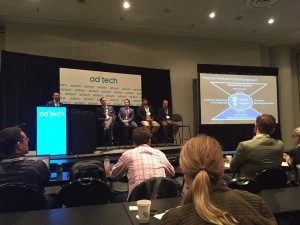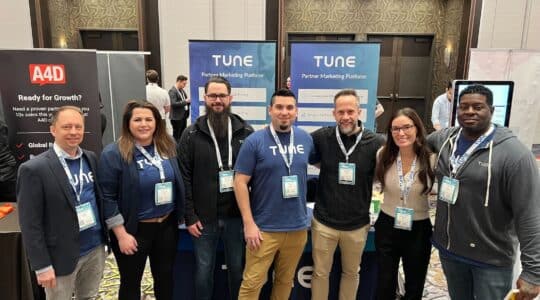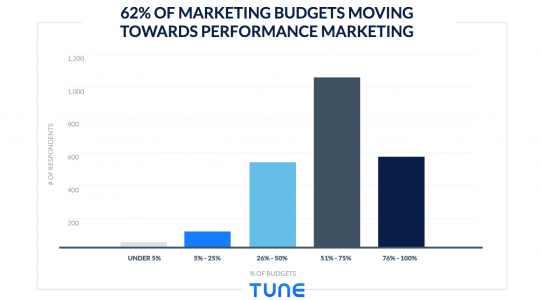Keeping in tone with ad:tech London last month, ad:tech New York had mobile in the forefront. Thousands of brands, agencies, media owners, tech providers, and investors gathered at the Javits Center to network and get insights from leaders in the industry. I was able to steal away from the TUNE booth to attend a couple sessions and hear how big brands do their marketing. I’d like to share some highlights from the sessions I attended.
Session: The last of the last click attribution
Panelists George Musi, managing partner of analytics, insights, and attribution at Mindshare and Clayton Ruebensaal, VP of global marketing transformation at American Express delved into different methods of click attribution. Their point was to focus on the entirety of the client journey, instead of assigning one single click to a purchase.
- Last click attribution leads to ads stalking consumers, they said. By relying on the last click, ads are desperate to be seen and seen often. By figuring out the full customer journey, the marketing experience for consumers will be enhanced.
But which touchpoints in said customer journey are most effective? For instance, Reubensaal said word of mouth is most influential for consumers to buy credit cards, but that is incredibly difficult to measure.
Methods
- Algorithmic attribution — Removes the subjectivity in attribution. We use machine-learning algorithms to calculate and fractionally assign credit.
- Ensemble methods — Draws from the wisdom of crowds, or multiple learning algorithms rather than a single model.
Key Takeaways
- The funnel is dead. The idea that marketers start with a lot of people and that population whittles down is no longer a valid marketing method. Modern day consumers now do their research and then make purchases based on that. People are constantly coming in and out of the purchasing cycle, not filtering out of the funnel.
- Integration is changing. It’s no longer about integrating messaging, but instead about integrating marketing and operations. Go beyond the messages. For instance, what happens in the sales process? What happens during the sales rep’s first interaction with a prospect is much more influential than a single banner ad or interstitial.
- Give credit where credit is due. Attribution is changing, and the future is to allocate partial value to different touch points within the customer journey that influenced the marketer’s desired outcome.
Keynote: Bottom line branding — Optimizing mobile and digital for deeper consumer engagement
Speakers:
John Costello, President, Global Marketing and Innovation, Dunkin’ Brands, Inc.
David Rosenberg, Managing Partner, IPG Media Lab,
Jay Henderson, Director of Offering and Product Management, IBM Marketing Cloud
Highlights:
“If you’re doing business like you did last week, competition is gaining on you. If you’re doing business like you did last month, competition may be beating you. If you’re doing business like you did last year, you may be out of business and not know it.” — John Costello
“Differentiate or die.” the stakes have never been as high for brands/companies as they are now. Fifty percent of fortune 500 companies from the year 2000 are gone. The Kodaks and Blockbusters are gone. — Joseph Jaffe
On why it’s hard for big companies to change
“We learn as kids that change is bad so as adults we’re stuck in our ways. A big part of what organizations are going to do is set the right tone. Embrace the fact that trying out new things is going to be part of how innovation occurs. At IBM, we’re focused on setting the right culture and tone so people feel comfortable branching out and accepting change.” — Jay Henderson
“Find out what is “intelligent change” — what do you preserve and what do you change. Values should be consistent. Food preferences, marketing techniques, populations change and we’re adapting to those. What are the core values that are a critical part of your success? Understand the tactics that may be changing quickly.” John Costello
How your company has acted more agile or pivoted for success
“Traditional marketing continues to work well for Dunkin’. In a company where traditional marketing is effective, we decided to go deep on mobile. We know mobile is transforming consumer engagement. For people on the run, mobile is strategically right. In a world where traditional marketing works well, it was a tough but right choice to go mobile.” — John Costello
Final Thoughts
Overall, I heard from all speakers that the marketing industry and mobile are changing. Not surprisingly, you must stay with and ahead of trends, listen to customers, and as the company grows, keep thinking of ways to stay innovative. IBM, a company with over 431,000 employees, keeps their focus by doing things such as investing in new technologies, but also deciding which paths they will not take is just as important. Whether a monster corporation or startup, innovation, creativity and focus should never be neglected.
Author
Becky is the Senior Content Marketing Manager at TUNE. Before TUNE, she led a variety of marketing and communications projects at San Francisco startups. Becky received her bachelor's degree in English from Wake Forest University. After living nearly a decade in San Francisco and Seattle, she has returned to her home of Charleston, SC, where you can find her enjoying the sun and salt water with her family.






Leave a Reply
You must be logged in to post a comment.